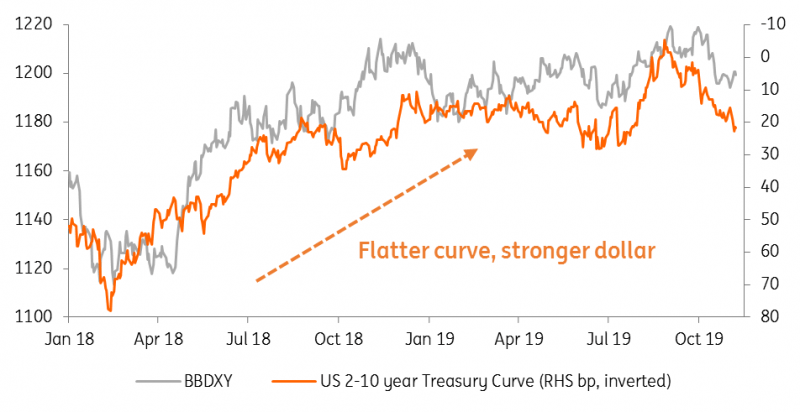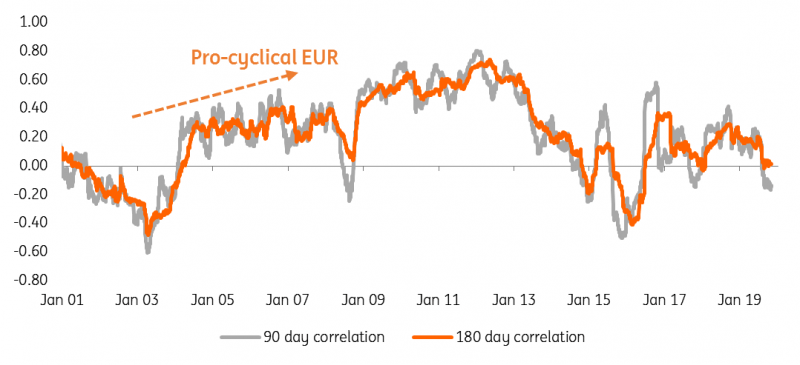The dollar had its worst month of the year in October, selling off by close to 2%. It is tempting to call this the top, but even if it is, the case for a higher EUR/USD is not particularly strong right now.
Yield curve steepens, dollar weakens
A combination of a better trade environment and softer US activity data saw the dollar sell off 2% in October. Activity currencies performed well, while a little more clarity on Brexit saw GBP lead European currencies higher across the board.
Once again the dollar moved in tandem with the US 2-10 year Treasury curve, which has proved a good barometer of secular stagnation fears this year. The third Fed cut and the détente on trade saw the curve steepen on optimism and activity currencies recover on the view that parking money in USD deposits was not the only game in town.
For the dollar to fall a lot further, however, would seem to require a big extension in some of these themes, such as:
US activity data deteriorating so significantly that the market prices a much deeper Fed easing cycle or
Much better activity data emerging overseas.
We tend to think the former is more likely than the latter (where European and Chinese activity still looks subdued), but our rates team are not big fans of the US 2-10 year yield curve steepening beyond this year’s range high of 30bp just yet. As such, we think it a little premature to be calling the dollar a lot lower – especially against the low-yielding EUR and JPY.
Dollar turns lower as US 2-10 year Treasury curve steepens
Source: Bloomberg, BBDXY = Bloomberg Dollar Spot Index
The drivers of the EUR are changing
Given the eurozone’s exposure to the global trade cycle, the euro has typically been seen as a pro-cyclical currency. Here, trade and the manufacturing sectors are seen as inextricably linked, based on the weight of intermediate goods in trade volumes. And for much of the last two decades, EUR/USD has had a positive correlation with world equity indices. ‘Risk on, dollar off’ has been a familiar refrain.
However, over the last several months, the positive correlation between EUR/USD and world equities has broken down. In fact, the 90-day correlation in changes between the two is now firmly negative. This relationship may have been distorted by the gyrations in GBP, but the move to a negative correlation is one which certainly bears watching. It warns that even if we do receive further positive developments on US-China trade - and equities rally - EUR/USD may not be a big beneficiary. This may be because the EUR is transitioning into a funding currency.
EUR/USD daily correlation with MSCI world equity index
Source: Bloomberg. Correlation in daily changes
The EUR as a funding currency
It is early days, but the EUR seems to be adopting the characteristics of a funding currency. We first highlighted this in our article ‘EUR: Misleading indicators, portfolio flows and hot money’, particularly with developments in the FX options market.
The BIS has recently released another set of data which tends to support this view. Here the locational set of banking statistics provide insights into cross-border borrowing by currency. The BIS provides an FX-adjusted set of quarterly figures, which we produce below.
Despite secular stagnation fears, total cross border borrowing on a year-on-year basis is actually rising at the fastest rate since the global financial crisis. And leading the charge is cross-border borrowing in the EUR. Over the last twelve months, participating banks report that their cross border lending in EUR has risen by near US$900bn, while USD lending has risen by around US$550bn.
It would seem that the EUR is becoming the preferred borrowing currency of choice, enjoying good liquidity, low volatility and most importantly, little risk of interest rates rising anytime soon. We’ve seen these trends emerge and weigh on the likes of the JPY and the CHF over the last two decades and see early signs of the EUR of crossing the floor to join these funding currency peers.
This would suggest that even if the risk environment does improve a lot, EUR/USD would lag. That's why we see EUR/USD continuing to trade near the 1.10 area over the next several months and only see limited upside – perhaps to the 1.15 area towards the end of 2020.
EUR cross-border lending takes off
Source: BIS, ING. Data is FX & Break adjusted.
GBP and the election
Elsewhere we expect GBP to consolidate ahead of the December 12th election – this because positioning is better balanced now and the volatility and quality of opinion polls will prevent large new positions being set. That probably means a 1.25-1.30 range for Cable and an 0.85-0.88 range for EUR/GBP. We’ll publish post-election GBP scenarios in a separate article.
Read the original analysis: USD: is this the top?
Content disclaimer: This publication has been prepared by ING solely for information purposes irrespective of a particular user's means, financial situation or investment objectives. The information does not constitute investment recommendation, and nor is it investment, legal or tax advice or an offer or solicitation to purchase or sell any financial instrument. Read more here: https://think.ing.com/content-disclaimer/
Recommended Content
Editors’ Picks
EUR/USD holds above 1.0700 ahead of key US data

EUR/USD trades in a tight range above 1.0700 in the early European session on Friday. The US Dollar struggles to gather strength ahead of key PCE Price Index data, the Fed's preferred gauge of inflation, and helps the pair hold its ground.
USD/JPY stays above 156.00 after BoJ Governor Ueda's comments

USD/JPY holds above 156.00 after surging above this level with the initial reaction to the Bank of Japan's decision to leave the policy settings unchanged. BoJ Governor said weak Yen was not impacting prices but added that they will watch FX developments closely.
Gold price oscillates in a range as the focus remains glued to the US PCE Price Index

Gold price struggles to attract any meaningful buyers amid the emergence of fresh USD buying. Bets that the Fed will keep rates higher for longer amid sticky inflation help revive the USD demand.
Sei Price Prediction: SEI is in the zone of interest after a 10% leap

Sei price has been in recovery mode for almost ten days now, following a fall of almost 65% beginning in mid-March. While the SEI bulls continue to show strength, the uptrend could prove premature as massive bearish sentiment hovers above the altcoin’s price.
US core PCE inflation set to signal firm price pressures as markets delay Federal Reserve rate cut bets

The core PCE Price Index, which excludes volatile food and energy prices, is seen as the more influential measure of inflation in terms of Fed positioning. The index is forecast to rise 0.3% on a monthly basis in March, matching February’s increase.


